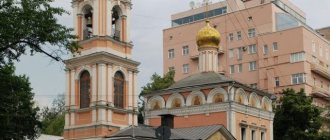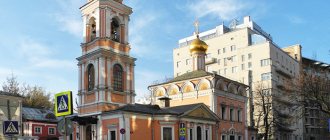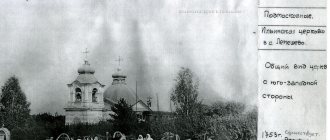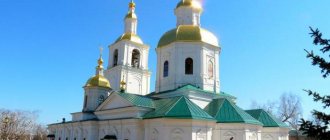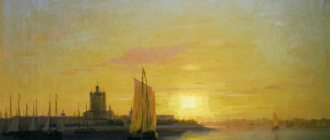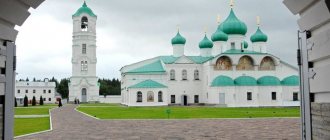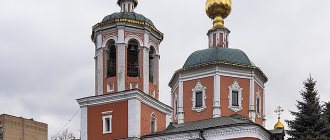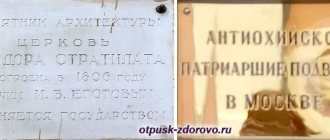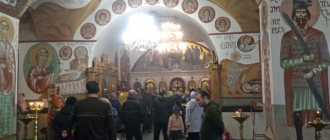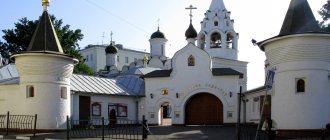The Jerusalem Compound in Moscow, the official website of which you will find in the “Information for Pilgrims” section, is located at the Church of the Resurrection of the Word, in Bryusov Lane. Some people confuse it with two temples at once: the Temple of the Jerusalem Icon of the Mother of God, which is located on the street. Talalikhin, 24, and the Church of St. Philip of Moscow, which is on Mira Avenue, but these are completely different churches.
This is a branch of the Jerusalem Orthodox Church, whose jurisdiction operates in Israel, Jordan, and Palestine.
History of the Church of the Ascension of the Word
You can find this building in the very center of Moscow, not far from Arbat, it is also called Filippovsky or Voznesensky.
Church of the Resurrection of the Word on Arbat, 1881 (photo by Nikolai Naydenov)
Historians have never been able to find out the exact time of its appearance: it is believed that a small wooden church was erected and named in honor of Metropolitan Philip, whose country house was located nearby. According to the second version, the church was built by the metropolitan himself.
This is interesting: Metropolitan Philip, who lived in the first half of the 16th century, became famous thanks to his denunciations of the guardsmen of Ivan the Terrible: sent into exile, he was killed by Malyuta Skuratov in his cell.
Unfortunately, there is no information left about these years: after the Time of Troubles and the Polish invasion, the building was either burned or destroyed so badly that it had to be restored from scratch. Due to money problems, the building was built only in 1688 - it was a stone structure that has survived to this day. Its restoration was carried out by steward Ivan Kosmin.
The building suffered for the second time during the Great Patriotic War with the French: it was looted and then burned in a fire. They were able to restore it only in 1815. The church did not have a parish, because of this it was impossible to raise the required amount on its own, and therefore it was assigned to the Church of St. Tikhon of Amathunt (now demolished).
Three years later, Patriarch Polycarp of Jerusalem turned to Emperor Alexander I with a request for help. 10 years ago, due to a severe fire in Jerusalem, the Church of the Holy Sepulcher and the shrines stored there were damaged. The Patriarch asked to allocate a small place for the brethren where they could stay and collect donations. This place became the Jerusalem courtyard created in the Philippov Temple.
As gratitude to the church, part of the Tree of the Holy Cross and the right hand of the Great Martyr Eustathius Placis were given to the church. In the same year, the name changed to Ascension of the Word.
At the beginning of the twentieth century, with the advent of Soviet power, the place was closed, but the church itself worked.
The editors of the site recommend reading an interesting article about the Church of the Intercession on the Nerl in the Suzdal region.
Historical place
On the site where the courtyard for the Jerusalem mission was established, there has been a church since the 16th century. It is believed that the original temple was built on the orders of Metropolitan Philip (Kolychev), at his country residence. The stone building appeared thanks to the efforts of boyar Ivan Kosmin during the reign of Alexei Mikhailovich, in 1966.
Nothing is known about how the temple developed until the 19th century. It is mentioned that during the capture of Moscow by Napoleon, the church shared the fate of most buildings in the capital - it was looted and burned down. In the summer of 1818, due to severe destruction of the temple and the small number of flocks, the Holy Synod decided to abolish the Philippian Church.
But providence decreed otherwise. In 1817, Emperor Alexander I received a request to grant the Patriarchate of Jerusalem a metochion in the capital of Russia to collect donations for the restoration of the Church of the Holy Sepulchre. The response to this initiative was the founding of the Jerusalem Metochion in Moscow.
Current state of the temple
The Jerusalem courtyard “returned” back in 1989. The first solemn service was conducted by Metropolitan Philaret, and was attended by Bishop Timofey, chief secretary of the Jerusalem Patriarchate, and Archimandrite Theophilak, who until 2001 was the rector of the metochion.
Thanks to the efforts of the latter, active restoration of the temple began: the icons in the external niches were restored, and a pilgrimage service was organized.
Please note: from 2003 until today, Stefan has been the rector.
In 1997, Moscow Patriarch Alexy II blessed the creation of the sisterhood. Sisters of mercy care for patients in the neurological department of Clinical Hospital No. 51, and also conduct conversations and, if desired, prepare for confession, communion and baptism. Today the number of sisters is 30 people.
Thrones of the Temple
The main altar was consecrated in honor of the feast of the Holy Resurrection, translated as “Renewal of the Church of the Resurrection of Christ in Jerusalem.” The church appeared in the 4th century, when the site of Christ's crucifixion was found. The Church of the Resurrection of Christ was built on this land, and it is customary to celebrate the date of completion of construction.
Please note: the holiday is celebrated on September 26th.
In Russia, the phrase “Speaking Resurrection” was used to denote this date. The word “wordy” comes from the words “to be known” or “to have a reputation.”
This is an important difference: according to the traditions of Russian Orthodoxy, the Jerusalem Resurrection Church could not be repeated: it is unique, and the building itself or the name cannot be copied. Therefore, all churches in Russia, including the Jerusalem courtyard, were dedicated to the holiday of the Erection of the Temple in Jerusalem, and not to the Resurrection of Christ itself.
The side altar is consecrated in honor of St. Nicholas the Wonderworker, the side chapels are in honor of the holy Apostle Philip and the Icon of Our Lady of Jerusalem.
After the revolution
The Jerusalem courtyard in Moscow was abolished immediately after the revolution, but the temple was closed only for a short time. In 1919, all the property of the farmstead became the municipal property of the Moscow City Council.
The Church of the Resurrection of the Word was closed in 1930, but during the war (1943) it was reopened to parishioners. An outstanding priest, Archpriest Alexander Skvortsov, became the rector of the church in difficult times for the country and the church. An equally famous clergyman, Protodeacon Mikhail Kholmogorov, served as clergy at the church.
Little information and documents have been preserved about how events developed and how the parishioners lived during the period of the atheism. It is only known that there was correspondence with government agencies about the restoration of the Jerusalem Metochion in Moscow and even certain agreements were reached, but they were not implemented.
Temple architecture
The church looks small: it is single-domed, with a bell tower-tent. The walls are bright red, with simple white decorations, golden domes and green roofs.
One of the main decorations are external icons: they are painted on the bell tower and walls.
Please note: the temple’s “neighbors” give it a special charm: the historical building stands out clearly against the background of the buildings of the 20th century.
Initially, the church was small, but in the middle of the 19th century a semicircular asp, a refectory and pediments on the north and south sides were added to the quadrangle. The original decoration was removed to make the windows wider. At the beginning of the twentieth century, a courtyard house was built near the temple.
Shrines of the Jerusalem Metochion in Moscow
There are several important shrines here:
- Part of the Tree of the Life-Giving Cross: this is a small piece of the cross on which Christ was crucified.
It is worth noting: in addition to the Church of the Ascension of the Word, particles of the Cross are kept in many churches around the world.
- Hand of the Great Martyr Eustathius Placidas: the saint lived in the 1st-2nd centuries and was killed for refusing to sacrifice to the gods. His memorial day is October 3.
- Relics of the Apostle James.
- The relics of the great martyrs Charalampios, Galaktion and Nikita, the great martyrs Varvara and Paraskeva Pyatnitsa, the martyr Tryphon and others.
Some icons are no less important:
- Our Lady of Kazan: her feast day is July 21. Its acquisition took place in Kazan after the conquest of the city by Ivan the Terrible.
- Our Lady of Jerusalem: her image was painted by the Apostle Luke. The holiday is October 12th.
- Our Lady of Akhtyrskaya: her day is July 2. The image was found in the city of Okhtyrka, now Sumy region (Ukraine).
- Our Lady “Quick to Hear”: the image was painted on the holy Mount Athos in Greece.
- Our Lady of Unexpected Joy.
- Great Martyr Eustathius Placidus: the saint lived in the 1st century and did good even before accepting Christ.
Historical information – Podvorye
The idea of creating a Serbian spiritual-organizational Center, a special courtyard, in Moscow has been brewing for a long time. The oldest local churches of the Orthodox East - Jerusalem, Antioch, Alexandria, Constantinople - already had similar courtyards with temples. The initiator on the Serbian side was Metropolitan Michael of Serbia. It is worth special mentioning this remarkable church figure of Serbia, a faithful friend of Russia. The future saint studied in 1840-1850 in Kyiv - at the seminary and the Theological Academy. Soon after completing the course, in September 1853, he took monastic vows with the name Michael. A year later, Hieromonk Michael was consecrated Bishop of Shabatsky. In 1859, the Council of Bishops unanimously elected Mikhail Metropolitan of Serbia and Archbishop of Belgrade. Under him, the seminary in Belgrade was transformed, several theological schools were established, and ancient churches and monasteries were restored. Spiritual unity with Russia was the principle of all his archpastoral activities.
In 1873, Metropolitan Mikhail petitioned the Synod for permission to open a Serbian metochion in Moscow. And soon, for this purpose, by the highest command, the Serbs were given the Church of St. Kira and John on Solyanka and the buildings located near it. This temple was built by the architect K.I. Blank in 1768 in memory of Empress Catherine II’s adoption of the Orthodox faith.
Chapel of Sava the Serbian at the Serbian Metochion - Annunciation Kiro-John Church (Photo from the book Architectural Monuments of Moscow / edited by I. E. Bondarenko M. 1904-1906)
In May 1874, the rector of the Gornyaksky (in the Belgrade Metropolis) monastery, Archimandrite Savva, arrived in Moscow and soon took over the management of the monastery on Solyanka. At the same time, a new throne was erected, renaming the temple in honor of the Annunciation of the Most Holy Theotokos. It was on the day of this great holiday in 1805 that the Serbs rebelled against the Turks.
On November 30, 1874, the church and courtyard were consecrated. The celebration was attended by many prominent figures of national culture, champions of the development of Serbian-Russian ties: the rector of Moscow University, historian S.M. Solovyov, the chairman of the Slavic Committee M.P. Pogodin, professor of Moscow University Archpriest A.M. Ivantsov-Platonov, as well as I. S. Aksakov, Yu.F. and D.F. Samarina.
March 22, 1875, the day of the small consecration of the Annunciation at the Serbian courtyard of the church, also became a holiday for Serbs and sympathizing Muscovites. Many eminent guests also took part in the celebration of the all-night vigil and liturgy: the sacellar of the Archangel Cathedral A.N. Lebedev, a member of the Synodal Office Bishop Alexy, Archimandrite Athanasius of the St. Nicholas-Greek Monastery, members of the Slavic Committee - Director of the Moscow Archives of the Ministry of Foreign Affairs Baron F.A. Buhler, secretary of the Slavic Committee N.A. Popov, famous political figure of Ugric Rus' O.N. Dobryansky. The service was performed to the accompaniment of ancient Serbian chants.
Renovated with funds from the Moscow merchant V.V. Sysoev and other donors, the temple represented a corner of Orthodox Serbia. The tall four-tiered gilded iconostasis was skillfully executed by master M.A. Bolshakov. All the icons were painted on a gold background, as were the walls. Of the thirty-three saints depicted here, eleven belonged to the Serbian Church, among them five were in the Russian calendar: St. Sava I, Archbishop of Serbia, his successor St. Arseny I, St. Serbian kings Stefan Nemanja the Myrrh-streaming (Simeon in monasticism), First-crowned Stefan (Simon in monasticism) and the Serbian prince Lazar. The names of many saints symbolized the spiritual unity of the two Orthodox peoples: Sts. Cyril and Methodius, St. Alexander Nevsky is the heavenly patron of the emperor, who granted the Serbian Hierarchy a courtyard in Moscow; Great Martyr Catherine - in memory of the empress who built the temple; righteous Filaret the Merciful - in memory of Metropolitan Filaret, who provided many services to the Serbian Church. Above the northern doors was depicted the burning of the relics of St. by the Turks. Savva, and above the southern ones - the suffering of the Ecumenical Patriarch St. Martyr Gregory V, whose relics, found incorrupt in 1871, rest in the Athens Cathedral.
Holy images also had special historical symbolism. The lower tier of icons included icons of the Holy Trinity, to which the temple was dedicated until 1768; Annunciation of the Blessed Virgin Mary, St. John the Baptist and St. Nicholas the Wonderworker. Six icons of the same size were placed on the walls: St. St. Andrew the First-Called, on the day of whose celebration Serbia received political and ecclesiastical independence, St. Cyrus and St. John (formerly the temple), St. Sava, the first Archbishop of Serbia, Moscow High Hierarchs, St. Sergius of Radonezh.
This temple-monument, amazing in its symbolism and significance, became the center for collecting monetary and other donations in favor of Serbian churches not only in Serbia, but also in Bosnia, Herzegovina, Vojvodina, Dalmatia, Croatia, Slavonia and other lands. At the courtyard, parishioners of many Moscow churches brought icons, which were then sent to poor churches in distant Serbia. Among the first, 26 old iconostasis images were sent from the church of the courtyard to the churches of Montenegro, devastated by the Turks.
The year of the final establishment of the Serbian metochion in Moscow became the year of the beginning of the bloody struggle for independence, decisive for the southern Slavs. Muslim oppression led in the summer of 1875 to a massive uprising in Bosnia and Herzegovina. News of the destruction and looting of churches by the Turks and the mass brutal murders of Orthodox Christians evoked a warm response from Muscovites. On Sunday, September 14, 1875, in the Annunciation Church of the Serbian Metochion on Solyanka, after the Divine Liturgy, a solemn requiem service was celebrated for the repose of “all Orthodox Christians in old Serbia, Herzegovina and Bosnia who suffered in Christ-loving and brotherly love.” Moscow newspapers published an appeal from Archimandrite Savva, who lived in the courtyard, about the terrible situation of the Serbs. After services in Moscow churches, a message from Metropolitan Michael of Serbia was read out and a plate collection was held for the affected residents of Herzegovina and Bosnia. (The archives of the Moscow Ecclesiastical Consistory contain subscription lists for the churches of all the Moscow forties.) In October 1875, the Moscow City Duma passed a verdict on the allocation of 20 thousand rubles for the same purposes.
1881, view of the Church of Cyrus and John from the northeast (there is no chapel yet). Photo from the book by N.A. Naydenov "Moscow. Cathedrals, monasteries and churches." 1882-83
Serbia and Montenegro came to the aid of their bleeding brothers in June 1876, declaring war on Turkey. Orthodox Moscow closely followed this unequal struggle. Russians were frequent guests of the Moscow Serbian courtyard. June 28, 1876, on the day of the celebration of St. miracle workers and unmercenaries Cyrus and John, a solemn prayer service was held in the Annunciation Church of the Metochion for the granting of victory to the Serbian and Montenegrin armies and victory over their enemies. Donations from Muscovites began to flow even more widely. The Old Believers of Moscow collected 30 thousand rubles, bought a camp hospital with 100 beds and sent it to Belgrade. At the expense of the famous Moscow professor Zakharyin, one of the doctors of the university clinic was sent to Serbia. A group of sisters of mercy from the Pokrovskaya women's community also went there. Dozens of armed volunteers were sent monthly to the army of General Chernyaev, who fought for the freedom of the Serbs. Despite help from Russia, the Serbian army suffered several serious setbacks and in February 1877, Serbia was forced to sign peace with Turkey. Only small Montenegro did not sign the peace treaty and, with the outbreak of the Russian-Turkish War in April 1877, managed to inflict a series of defeats on the Turks. Thus, in the summer of 1877, an 8,000-strong detachment of Montenegrins defeated the 40,000-strong corps of Suleiman Pasha. On the occasion of this victory, thanksgiving prayers were served in the Moscow Serbian courtyard and in the Kazan Cathedral on Red Square.
At the end of 1877, Serbia again started a war with Turkey. After the end of the Russian-Turkish war, Serbia and Montenegro received complete independence. In honor of the victories of Russian troops in the Balkans and the liberation of the Slavs, solemn prayer services were held in a number of cathedrals and churches in Moscow, including the Serbian courtyard. On November 5, 1878, the Solyanka courtyard again attracted many guests. On this day, a minor consecration of the Annunciation Church took place, which was repaired mainly at the expense of the church warden, the famous Moscow merchant S.I. Kamynin. The iconostasis was again gilded, the wall paintings were updated, and four large gilded icon cases were installed behind the choirs. In his sacramental speech, a professor at Moscow University, Doctor of Theology, Archpriest A.M. Ivantsov-Platonov, recalled how four years ago the opening ceremony of the first Slavic - Serbian - metochion took place in Moscow. The banner presented by Muscovites to the Serbian squads in 1876 was brought in. Famous guests were present at the celebration, including P.N. Batyushkov and D.I. Ilovaisky. The many years of devastating war left thousands of children orphans in Serbia and Montenegro. Russia has become a home for many of them. In January 1877, 21 girls and 2 boys aged 6 to 14 years arrived in Moscow from Serbia for the care of the Slavic Committee. And later Moscow accepted Serbian orphans, who were then placed in orphanages.
Many people from the South Slavic regions studied at Moscow University, the Theological Academy, and other educational institutions. The Serbian courtyard was a kind of spiritual and cultural center for Orthodox student youth. At the courtyard, the tradition of joint celebration of civil and church holidays by Serbs and Russians continued. On October 10, 1880, a funeral service was held in the Annunciation Church for the first rector of the Serbian metochion, Archimandrite Savva, who was later buried in the Alekseevsky Monastery.
The Serbian metochion in Moscow continued to significantly influence the financial situation of the entire Serbian Church. Thanks to the generous donations of Muscovites to the Church of the Annunciation, many poor monasteries and churches in Serbia were decorated with valuable utensils and vestments.
However, already the first years of Serbian independence were overshadowed by discord caused by the Assembly's encroachment on the rights of the Orthodox Church. Metropolitan Michael hotly rebelled against this, for which in October 1881 he was removed from the metropolitan throne by King Milan and even imprisoned for several months. The Metropolitan, who had done so much for the liberation of his homeland, was forced to live either in Bulgaria, or in Constantinople, or in Jerusalem. In 1883 he received permission to settle in Russia. In the same year, the suffering hierarch came to Kyiv, and then to Moscow to the Serbian courtyard, which was placed at his disposal. As contemporaries recalled, “the sufferer acquired general love and respect among the residents of the capital... Moscow passionately fell in love with the kind, intelligent, meek old man, who found a second home in her.”
Church of the Annunciation of the Blessed Virgin Mary at the Serbian Compound. Vostryshev, Shokarev “Orthodox Moscow. All temples and chapels." M. 2012.
The exile lived on Solyanka until May 1889, when, at the suggestion of the new Serbian king Alexander I, he returned to Belgrade to the metropolitan throne. Saint Michael of Serbia was awarded many orders of Russia: St. Vladimir I and II degrees, St. Alexander Nevsky, St. Anna and others. He was elected an honorary member of the Moscow Theological Academy and Moscow University. Metropolitan Michael died on February 5, 1898 and was buried in Belgrade’s St. Michael’s Cathedral. When they found out about this in Moscow, memorial services were held in many of its churches.
Holidays in memory of the first archbishop and educator of Serbia, St. Savva. On this day, January 14, all Serbs living in Moscow were present at the Divine Liturgy in the church. This is how, for example, the holiday took place in 1893. At the end of the service, the traditional Serbian rite of “Glory” and “Name of the Cross” took place in the chambers of the rector, Archimandrite Savva. Serbian students sang the hymn of St. Savve, Russian and Serbian. Then speeches were made about St. Savva, about the friendship of the Serbs with the Russians. Thus, a fourth-year student at the Moscow Theological Academy, Ch.I. Mitrovich, remembered the Russian monastery on Mount Athos, where he took monastic vows to St. Savva, about the great Serbs in Russia, about Russia’s constant intercession for the Serbs. In 1894, at the entrance from Solyanka to the courtyard, next to the Annunciation Church, at the expense of the Moscow merchant I.I. Siluanov, a chapel was built in the name of St. Savva (architect M.S. Shutsman). The laying of the stone took place on June 12, 1894 and was accompanied by a religious procession from the temple to the construction site.
Along the way, let’s talk about one more South Slavic “trace” in the religious life of Moscow. Moscow pilgrims and experts in ancient architecture knew well the white stone church of St. Tryphon the Martyr on the northern outskirts of the city. At the end of the 18th - beginning of the 19th century, its parish was empty and even the idea of abolishing the temple itself appeared. Its revival was facilitated by a visit to Moscow by the archimandrite under the Metropolitan of Montenegro, Stefan Vukotic. In the cathedral of the city of Kotor in Montenegro the head of St. Martyr Tryphon. Having learned about the arrival of Vukotich, the Moscow merchant and silversmith Trifon Dobryakov wished to create a worthy shrine for the relics of his heavenly patron. Upon returning to his homeland, the archimandrite told Metropolitan Peter Njegos of Montenegro about the desire of the Moscow merchant, and as a sign of gratitude, the latter sent in 1803 three parts of the relics from the head of the martyr Tryphon. Dobryakov put them in gilded silver boxes and presented them in 1812 to Emperor Alexander I, who in turn donated them in 1819 to the Trifonovsky Church. The day of the transfer of the relics on September 14 became an annual local holiday, and the revival of the temple began with it. High-ranking Montenegrin guests who came to Moscow would certainly visit the Trifonovsky Church and venerate the relics.
Orthodox Moscow saw in its churches parts of other holy relics brought from Serbia. Thus, in the fall of 1893, parts of the relics of the Great Martyr Nikita and St. Theoktist, sent from the Serbian monastery of Vysoki Decani, were placed in the Cathedral of Christ the Savior. Offerings to them helped restore the ancient monastery of Serbia.
In 1912-1913, Moscow, like thirty-five years ago, came to the aid of the South Slavs, bogged down in the Balkan wars, including Serbia and Montenegro. In December 1912, the Montenegrin Queen Milena sent a telegram to the Moscow mayor expressing gratitude for the donation of 15 thousand rubles to Montenegro. Moscow banks, charitable societies, and individuals donated significant sums to help the Orthodox Christians of Serbia and Montenegro.
The most difficult test for Serbia was the First World War. Austria-Hungary attacked her with all its might. This caused an outburst of solidarity with the Serbs in Moscow. On July 18, 1914, in the evening on Red Square at the monument to Minin and Pozharsky, with a large crowd of people, a solemn prayer service was held, and then a patriotic meeting. The procession moved from the Cathedrals of Christ the Savior and St. Basil to the monument. The banner bearers carried icons of the Savior, the Mother of God, Saints Alexis and Hermogenes, as well as the national flags of Russia and Serbia, portraits of Nicholas II and the Serbian King Peter. The religious procession was accompanied by the singing of a choir of thousands. Czech and Serbian greetings were heard on Red Square. On the same day, a prayer service was held in the church of the Serbian courtyard for the sending of victory to the Serbian weapons. After the prayer service, a meeting of the Slavic Committee opened under the chairmanship of the mayor N.I. Guchkov. It was decided to issue a special appeal to Russian society calling for help for the Serbs. The meeting was attended by the Moscow provincial leader of the nobility A.D. Samarin.
A huge demonstration of Muscovites took place on the same day on Strastnaya Square at the monument to the hero of the Russian-Turkish war, General Skobelev. From there, the demonstrators headed in columns to the Kremlin and to the Alexander Station. Members of the Union of Michael the Archangel and the Union of the Russian People carried huge banners with the inscriptions: “Down with Austria, long live Russia and Serbia!”, “Long live Russia - the sister of Serbia!”
Moscow, despite the difficult economic situation, sent doctors and nurses, equipment for hospitals, and money to Serbia. In April 1916, Muscovites greeted Serbian Prime Minister N.P. Pasic with enthusiasm. On behalf of the Moscow City Duma, he was awarded 100 thousand rubles to help fighting Serbia.
In 1918, along with other Orthodox farmsteads, Serbskoye was closed, and the Annunciation Kiro-John Church was made a parish church. In 1933, the temple and chapel were destroyed. However, the spirit of unity of the Russian and Serbian peoples has not faded. After the Russian revolution, Serbia sheltered thousands of Russian refugees. Nowhere in Europe did Russian emigrants live as calmly as in Serbia of the same faith.
The centuries-old fraternal relations between Russians and Serbs are strong today. The latest dramatic events in the former Yugoslavia and the reaction to them in Russia are clear evidence of this.
Source: V.F. Kozlov “SERBIAN COMPOSITION IN MOSCOW” Published: “Moscow Journal” 5'1999
Information for pilgrims
All information necessary for pilgrims can be found on their website. Unfortunately, the temple is too small and does not have its own hotel and tourist office.
Hotel Russo-Balt
Tourists can stay at the nearby hotels: Flamingo, Russo-Balt, Apartments on Gogolevsky Boulevard.
Please note: The Jerusalem Compound organizes excursions for its pilgrims to the holy places of Russia and the world. More information can be found on the website or in the temple itself.
Sunday School and Social Ministry
In 2002, the Jerusalem Compound in Moscow opened a Sunday school, where children and adults are invited. By now, the children's department has merged with the spiritual music department. For the younger generation of parishioners, classes are held in drawing, musical disciplines (solfege, choral singing), and handicrafts. Teaching is conducted in the subjects of the Law of God, the culture of Orthodoxy, and artistic expression.
Adult Sunday school attendees study the Old and New Testaments of the Holy Scriptures, the history of Christianity, the Law of God, and much more. For parishioners, excursions and pilgrimages are held to historical places in Moscow and the surrounding area, as well as pilgrimages to holy places in the capital and nearby settlements. Trips are carried out in the form of bus tours and walking tours. Anyone can enroll in the school by contacting the Jerusalem Compound in Moscow. The schedule of trips and classes will be confirmed at the temple.
The social service of parishioners and servants of the Church of the Resurrection of the Word began in 2010, at the same time a group of volunteers was organized to implement tasks and provide all possible assistance. It includes people of many professions, united, they help pensioners, low-income people, large families and other socially vulnerable people. A survey is being conducted at the temple, a special stand has been created with the necessary information on where to go on important issues, and fundraising has been organized for the benefit of those in need.
Temple address and official website
Official website https://podvorie.orthodoxy.ru. Here you can find out all the necessary information: the history of the place, information about shrines, etc.
The church is located at: Filippovsky Lane, building 20.
Depending on the metro station, you can go in the following ways:
- Arbatskaya Filevskaya line : after leaving the metro, you need to turn left and cross Gogolevsky Boulevard. Then go to Maly Afanasyevsky Lane and at the first turn turn left onto Filippovsky Lane.
Please note: the Embassy of Turkmenistan can serve as a reference point: it is adjacent to the temple.
- Arbatskaya Arbatsko-Pokrovskaya line : after leaving the metro, you need to turn left and walk to Gogolevsky Boulevard, cross it and turn left. Then go straight to the intersection with Maly Afanasyev Lane.
- Kropotkinskaya : you will need to go towards Gogolevsky Boulevard and walk along it 2 stops towards the Old or New Arbat. Gogolevsky Boulevard itself can serve as a landmark: it is a green park that stretches from the station to Maly Afanasyevsky Lane.
Phone - (495) 690-5701.
Schedule of services
You can see the detailed schedule at https://podvorie.orthodoxy.ru/raspisanie/. Almost every day, services in honor of the saints are held in the temple; the schedule is drawn up for a week and is regularly updated.
Visit to the temple by His Beatitude Patriarch Theophilos of Jerusalem
The main services are held on Orthodox holidays (Christmas, Easter, etc.), as well as on the days of the patrons of the temple, the main icons and shrines.
Traditionally they are performed:
- on weekdays – at 8:00 and 18:00;
- on Sunday – at 9:30 and 18:00.
Please note: times may be subject to change, so it is best to check in advance. For example, there may be only one service (at 8:00) or shifted to 9:00.
The Jerusalem Metochion in Moscow is a “branch” of the Orthodox branch. This is an important place for many believers, which symbolizes the friendship between the two diptychs of the patriarchate - Jerusalem and Russian.
We present to your attention a video about the Jerusalem Metochion in Moscow:
Base
The Jerusalem courtyard in Moscow appeared at a difficult time for Russia. Just recently the war with Napoleon ended, the country was being restored, and Moscow, which had been burned, was being rebuilt. In 1815, Archimandrite Arseny was appointed to collect donations.
He managed to find a response to his call among the people and the royal dynasty. Donations came from all over the country. In 1817, the Holy Synod issued a decree on the creation of a Jerusalem metochion at the Church of the Holy Apostle Philip near the Arbat Gate.
Photo gallery
[Show slideshow]
